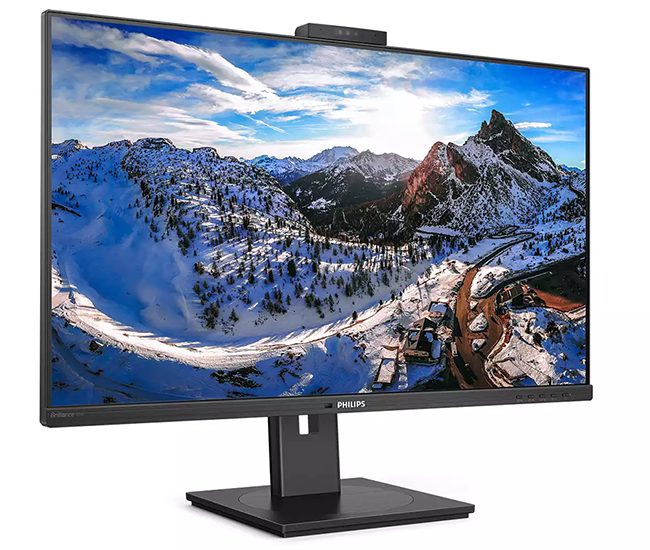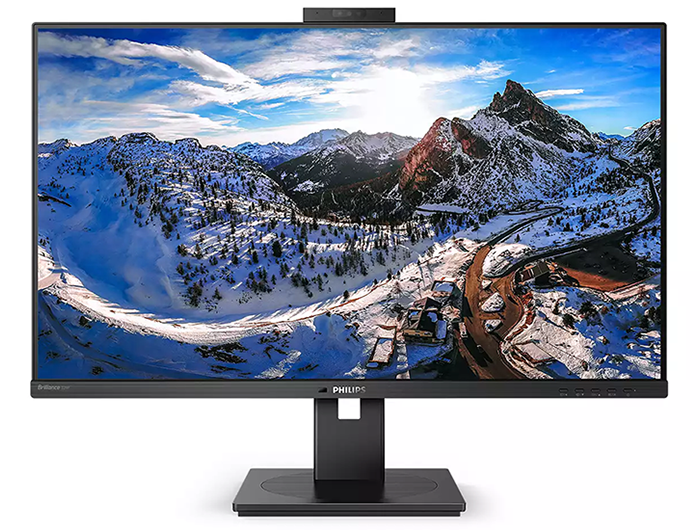Introduction
Appreciating the newfound benefits of working from home? Then you might be inclined to upgrade your setup, and there's no better place to start than a high-quality display. A bigger screen and a higher resolution are typical attractions, but today's office-centric solutions are available with a growing range of value-adds and the Philips Brilliance 329P1H has enough up its sleeves to be deemed a well-rounded contender.
Touting a 31.5in 4K IPS panel, the 329P1H ticks the boxes for both size and resolution, and the 3,840x2,160-pixel count works well at these proportions. Most users will want to adjust desktop scaling to 125 or even 150 per cent - native 100 is a tad too small for our liking - but 8.3m pixels ensure pin-sharp images with crisp text. Whichever scaling mode you settle on, you will appreciate the extra desktop real estate, particularly if migrating from a smaller, FHD panel.
Philips' implementation is reasonably sleek, with a matte-black frame plus thin bezels on the top and sides, but the stand's 280mm x 280mm footprint does eat up a fair amount of room. We'd prefer a rectangular base that doesn't jut forward quite so far. Still, the supplied stand has a nice weighty feel to it and offers good manoeuvrability, with 180mm height adjustment, -5°/+25° tilt, 180° swivel and, if need be, the ability to rotate into portrait mode.
Do be aware that the monitor tips the scales at just over 12kg and measures 714mm x 649mm x 280mm with the stand at its maximum height, so you'll need a good-sized sturdy desk, or if you prefer to use your own mounting kit the supplied stand is easily removed to reveal a 100mm VESA mount. In keeping with other monitors in the Brilliance range, there's also a LowBlue mode that promises to be easier on the eye, and an integrated IR PowerSensor that can be used to automatically dim display brightness when the user isn't present.
Tactile buttons, while not as convenient as a joystick, make light work of navigating the OSD, but what really helps set the Philips Brilliance 329P1H apart from regular 4K office displays is the integration of a USB-C docking station with power delivery. The single port allows for an attached laptop to charge at up to 90W, and in addition to carrying both video and audio to the big screen, the laptop can borrow peripherals and wired Internet access from the monitor's USB and Ethernet ports.
Speaking of ports, there are four USB 3.2 Gen 1 Type-A downstream, the aforementioned USB 3.2 Gen 2 Type-C upstream, Gigabit Ethernet, headphone jack, DisplayPort 1.4, two HDMI 2.0 and a three-pin connector for the integrated power supply. Two of the four USB Type-A are helpfully located on the monitor's side for easier access, and if you're hoping to keep external clutter to a minimum, integrated 5W stereo speakers do a decent enough job of driving everyday audio.
Completing the one-stop proposition is a pop-up webcam. Philips' two-megapixel FHD camera does sound a step up from the norm, yet while the 1080p resolution is welcome, image quality remains noticeably grainy and lacking in quality. Still, in this day and age it's handy to have a camera included, and better still there are accompanying IR sensors for Windows Hello face recognition, allowing for a quick login when you take your seat. The one frustration is that it is almost impossible to release or stow the camera without inadvertently shifting the display down the vertical axis; there needs to be a way to lock the height adjustment at the desired level.
Another potential sticking point is the £519 MSRP. There's a premium attached to the USB-C docking station and pop-up camera, but stock shortages and limited availability are such that the monitor is currently proving impossible to find at anywhere near the advertised fee. When/if prices do begin to settle, the 4K 60Hz panel itself needs to be relatively accomplished for the 329P1H to be worthy of consideration. Let's run the benchmarks to see how it stacks up.












